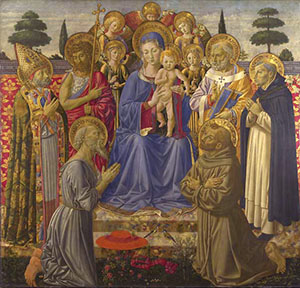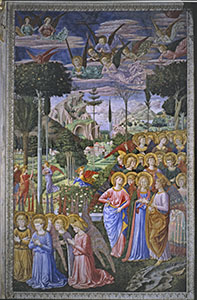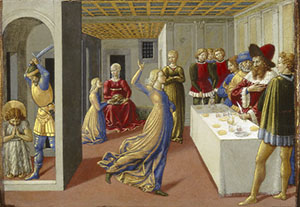
Altarpiece of the Purification, National Gallery, London.

Angels in Adoration, Chapel of the Magi, Florence.

Herod’s Banquet, National Gallery of Art, Washington.
Benozzo was born and grew up in Florence where he developed professionally in what was a fundamental era in the history of Italian art. Indeed, in the years between 1430 and 1440 some of the most famous and innovative painters of the period worked in the city: Filippo Lippi, Paolo Uccello, Domenico Veneziano, Piero della Francesca and Beato Angelico.
It was precisely with Angelico that Benozzo undertook the first significance works that today enable us to reconstruct the activity of the young artist, such as the fresco decoration of the Convent of San Marco in Florence.
On completing this assignment in 1444, Benozzo committed himself to working with Lorenzo Ghiberti until 1447 on the second door of the Baptistery, the so-called Gate of Paradise.
From 1447 to 1459, the painter is documented as living and working in Lazio and Umbria. It has been suggested that during this period away from Florence he made a brief return to the city, probably before 1450, to collaborate on the painting of the panels that decorated the Closet of Silver produced by Beato Angelico for the small oratory attached to the Chapel of the Santissima Annunziata.
After the death of Angelico, Benozzo, who was in Rome, decided to return to Florence where he received an assignment of great prestige: Piero de’ Medici, who was supervising the construction and furnishing of the new family palazzo in Via Larga, commissioned the artist with the painting of the residence’s private chapel, and thus in 1459 Benozzo executed with his customary masterly skill and richly varied and animated style the splendid Procession of the Magi.
On completion of this imposing work, the painter carried out numerous works on panel, including The Altarpiece of the Purification commissioned in 1461 for the altar of the Company of the Purification of the Virgin, a confraternity that was established in the Convent of San Marco in Florence. This was one of the last works by the artist before leaving the city again. The main panel is now at the National Gallery in London, while the four elements of the predella are respectively preserved at the Gemäldegalerie in Berlin (San Zanobi resuscitates a child), the Royal Collection in London (the Fall of Simon Magus), the National Gallery of Washington (the Feast of Herod) and the Museum of Art in Philadelphia (the Presentation of Jesus at the Temple).
Benozzo did not return to Florence until 1495, at that time in the midst of great ideological upheaval: on one hand, the expulsion of the Medici family, on the other, the public preachings of the monk Savonarola, an ardent and courageous promoter of reform in costume (starting with the clergy) and advocate of the people (opposed, therefore, to the oligarchic dominance of the Medici), in whom he saw the healthier part of society.
Worthy of mention among Benozzo’s final works due to their refined execution is the small panel depicting the Penitence of Saint Jerome, preserved at the Museo Bardini in Florence. Also preserved in Florence, at the Museo Horne, is the Deposition, one of two oils on canvas painted for Bishop Pandolfini of Pistoia, the city where Benozzo had been called to undertake a new commission and which remained unfinished due to the death of the artist on 4th October 1497.
Serena Nocentini